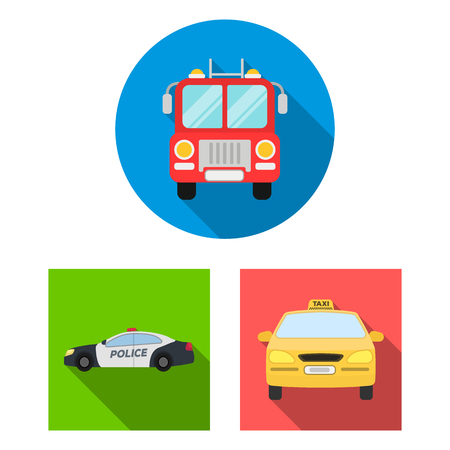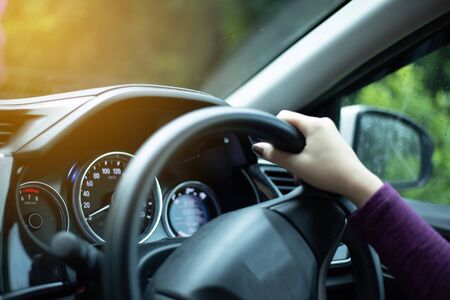1. Maintain a Safe Following Distance
One of the most important defensive driving techniques for highway and interstate driving is keeping a safe following distance. Maintaining enough space between your vehicle and the car in front of you gives you enough time to react and stop safely in case of sudden braking or emergencies.
The Three-Second Rule
A helpful way to ensure a safe following distance is by using the three-second rule. Here’s how you can apply it:
| Step | What to Do |
|---|---|
| 1 | Pick a stationary object on the side of the road (e.g., a sign or a mile marker). |
| 2 | When the vehicle in front of you passes that object, start counting: “one thousand one, one thousand two, one thousand three.” |
| 3 | If you pass the object before you finish counting, youre following too closely. Increase your distance. |
When to Increase Your Following Distance
In some situations, a three-second gap may not be enough. Increase your following distance in these conditions:
- Bad Weather: Rain, snow, or fog can make roads slippery and reduce visibility.
- Heavy Traffic: Stop-and-go traffic can lead to sudden braking.
- Night Driving: Reduced visibility at night requires more reaction time.
- Large Vehicles Ahead: Trucks and buses block your view of traffic conditions.
Why This Is Important
Keeping a safe following distance helps prevent rear-end collisions and gives you enough reaction time if the driver in front suddenly stops. It also helps reduce stress and makes highway driving smoother and safer for everyone.
2. Use Mirrors and Check Blind Spots Frequently
Regularly checking your mirrors and blind spots is a crucial habit when driving on highways and interstates. Traffic moves fast, and cars can quickly enter your blind spots without you noticing. Before changing lanes, always take a moment to check your mirrors and physically turn your head to look over your shoulder.
How to Use Your Mirrors Effectively
Proper mirror use helps you stay aware of your surroundings. Here’s how to adjust and use them effectively:
| Mirror | Adjustment Tips |
|---|---|
| Rearview Mirror | Position it so you can see directly out of the rear window without moving your head. |
| Side Mirrors | Adjust them so you can see a small portion of your own vehicle while maximizing your view of adjacent lanes. |
Checking Blind Spots
No matter how well your mirrors are adjusted, they won’t cover your blind spots entirely. Here’s how to check them safely:
- Turn your head briefly to look over your shoulder before switching lanes.
- Be cautious of vehicles, especially motorcycles, which can be harder to see.
- Use your peripheral vision to stay aware of nearby cars even when looking forward.
Common Mistakes to Avoid
Avoid these common mistakes when using mirrors and checking blind spots:
- Relying solely on mirrors without physically checking blind spots.
- Adjusting mirrors improperly, creating large blind spots.
- Failing to check before merging or exiting highways.
Stay Alert and Aware
By making it a habit to check mirrors and blind spots regularly, you can significantly reduce the risk of collisions on busy highways and interstates. Stay alert and always be aware of the vehicles around you.

3. Stay Aware of Surrounding Traffic
Continuously scan the road ahead, behind, and to the sides to anticipate potential hazards and avoid sudden surprises. Staying aware of your surroundings helps you react quickly to changing traffic conditions and prevents unnecessary risks.
Keep Your Eyes Moving
Instead of fixating on a single point, shift your gaze frequently to monitor different areas around your vehicle. Watch for slowing traffic, merging cars, and sudden lane changes. This habit improves your reaction time and allows you to prepare for unexpected situations.
Use Your Mirrors Effectively
Regularly check your rearview and side mirrors to stay informed about vehicles around you. Adjust your mirrors to minimize blind spots and glance at them every few seconds to maintain situational awareness. Keeping track of nearby cars helps you predict potential movements and drive defensively.
Watch for Brake Lights and Turn Signals
Pay attention to the brake lights and turn signals of vehicles ahead and around you. Sudden braking or lane changes can indicate possible obstacles or slowdowns. Staying alert to these signals allows you to adjust your speed or position accordingly.
Be Mindful of Blind Spots
Every vehicle has blind spots where other cars may not be visible in the mirrors. Always do a quick head check when changing lanes to ensure no one is in your blind spot. Avoid lingering in other drivers blind spots, as they may not see you when switching lanes.
Situational Awareness Checklist
| Action | Benefit |
|---|---|
| Scan the road ahead | Spot potential hazards early |
| Check mirrors every few seconds | Stay updated on surrounding traffic |
| Look for brake lights and signals | Prepare for slowing or stopping vehicles |
| Avoid driving in blind spots | Reduce the risk of unseen lane changes |
By staying aware of your surroundings at all times, you reduce the chances of being caught off guard by sudden hazards. Keeping your attention on the road and traffic conditions allows for safer and smoother highway driving.
4. Adjust Speed According to Road and Weather Conditions
Modify your speed based on traffic flow, road conditions, and weather to maintain control and reduce accident risks. Speed limits are set for ideal conditions, but you should always adjust based on the actual situation. Driving too fast or too slow can both be dangerous.
How to Adjust Your Speed Safely
- Match Traffic Flow: Stay with the general speed of traffic while keeping a safe following distance.
- Slow Down in Poor Weather: Rain, fog, or snow decrease traction and visibility. Reduce speed accordingly.
- Adapt to Road Conditions: Curves, intersections, and work zones require slower speeds to stay in control.
- Be Cautious at Night: Reduced visibility at night means you should lower your speed and stay extra alert.
Recommended Speed Adjustments
| Condition | Recommended Speed Adjustment |
|---|---|
| Heavy Rain | Reduce speed by 5-10 mph and increase following distance |
| Fog | Drive below speed limit and use low-beam headlights |
| Snow or Ice | Reduce speed by at least 50% and avoid sudden movements |
| Curvy Roads | Slow down before entering the curve and accelerate gradually |
| Night Driving | Drive slightly below speed limit and stay extra cautious |
Why Speed Adjustment Matters
Speeding in unsafe conditions increases braking distance and the risk of skidding or losing control. On the other hand, driving too slowly can disrupt traffic flow and cause rear-end collisions. Always stay aware of your surroundings and adjust accordingly.
5. Use Signals and Communicate with Other Drivers
Always use turn signals when changing lanes or exiting highways, and make eye contact or use hand gestures when necessary to indicate intentions. Proper communication on the road helps prevent confusion and reduces the risk of accidents.
Why Signaling is Important
Using your turn signals is one of the simplest yet most effective ways to let other drivers know your intentions. It allows them to adjust their speed or position accordingly, which helps maintain a safe and smooth traffic flow.
When to Use Turn Signals
| Situation | When to Signal |
|---|---|
| Changing lanes | At least three seconds before moving |
| Exiting a highway | About 100-200 feet before the exit |
| Merging onto a highway | Before entering the highway lane |
Other Ways to Communicate
Besides turn signals, you can use other means to communicate with drivers:
- Eye Contact: Helps confirm that other drivers see you, especially at intersections.
- Hand Gestures: If needed, use simple and clear hand signals to indicate direction (avoid rude gestures).
- Brake Lights: Tap them briefly to warn vehicles behind you of slowing traffic.
Avoid Assumptions
Even if you signal, never assume other drivers will react appropriately. Always check your mirrors and blind spots before changing lanes or merging. Defensive driving means anticipating possible mistakes from others.
6. Avoid Distractions and Stay Focused
Keep your attention on the road by avoiding phone use, adjusting in-car settings before driving, and minimizing any other distractions. Staying focused while driving on highways and interstates is crucial for your safety and the safety of others. Here are some practical tips to help you stay distraction-free:
Put Your Phone Away
Using your phone while driving is one of the biggest distractions. Even hands-free calls can take your attention away from the road. It’s best to silence notifications and place your phone out of reach to avoid the temptation of checking it.
Adjust Settings Before You Start Driving
Before you hit the road, take a few moments to adjust your seat, mirrors, GPS, and climate control. Doing this beforehand helps you keep your hands on the wheel and your eyes on the road.
Minimize Other Distractions
Besides your phone, other things can take your attention away from driving. Keep distractions to a minimum with these tips:
| Potential Distraction | How to Minimize It |
|---|---|
| Loud music | Keep the volume at a moderate level so you can hear surrounding traffic. |
| Eating and drinking | Eat before driving or pull over if you need to have a snack. |
| Conversations with passengers | Keep discussions light and avoid deep focus on non-driving tasks. |
| Reaching for objects | Store needed items within easy reach before driving. |
Stay Mentally Focused
Highway driving requires constant attention, especially at high speeds. Keep your mind engaged by staying alert to traffic flow, upcoming exits, and road conditions. If you feel tired or distracted, take a break at a rest stop before continuing.
Be Aware of Others Distractions
Even if you stay focused, other drivers might be distracted. Watch for erratic driving behaviors, such as sudden lane changes or inconsistent speeds, and keep a safe distance from drivers who seem inattentive.


